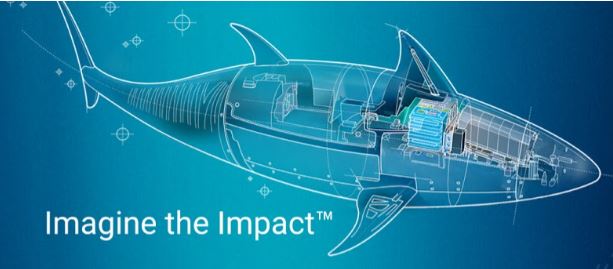Biomimicry and Underwater Robotics: How Copying Nature's Design Leads to Innovative Solutions
Taking inspiration from nature can lead to groundbreaking innovations, as this advanced underwater robot showcases.
The below article, summarizing a presentation given by Boston Engineer President Bob Treiber, explores the journey from copying a fish to developing advanced underwater robotics, while highlighting the immense potential of biomimicry in solving complex problems and shaping the future of the technology.
Learn More about Boston Engineering Robotics Expertise

The concept of biomimicry, where humans mimic nature's designs and processes to solve complex problems, has paved the way for groundbreaking advancements in various fields. One such remarkable application is in the realm of underwater robotics, where Boston Engineering engineers have looked to the natural world for solutions to create highly maneuverable and efficient underwater autonomous vehicles.
Biomimicry involves learning from biology and mimicking nature's perfected designs and processes, which have evolved over millions of years. This approach has led to innovations that have revolutionized various industries. Examples include the silent flight of owls inspiring quieter aircraft and the skunk's odorant secretion inspiring the safety feature of adding scent to odorless natural gas.
The Underwater Challenge: One of the significant challenges in underwater robotics is creating machines that are highly maneuverable and energy-efficient, capable of performing complex tasks in challenging underwater environments. Traditional remotely operated vehicles (ROVs) excel in linear movements but struggle with agility and versatility.
The Fish-Inspired Solution: The robotics team at Boston Engineering turned to nature for inspiration. They selected the tuna as their muse, a fish known for its remarkable speed, maneuverability, and efficiency. The tuna's unique swimming motion, where only the rear third of the fish moves while the front remains focused on the target, became a pivotal design element.
Reverse Engineering Nature: To replicate the tuna's motion and efficiency, the team embarked on a journey of reverse engineering. They meticulously measured and analyzed the fish's physical attributes, from its skeletal structure to its muscles. This detailed understanding allowed them to create an exact replica of the fish's physical form, a crucial step in the biomimicry process.
Digital Twin and Evolution: Mimicking the physical form was just the beginning. The team also sought to replicate the fish's motion. They used a genetic algorithm and real-time measurements to evolve the fish's swim profile continually. By comparing the fish's performance with various swim profiles, they selected the most efficient ones, mimicking the process of natural selection. Learn More about this and other digital solutions
First Prototypes and Field Trials: The team's dedication and innovation bore fruit with the successful creation of the first prototypes of their biomimetic fish. These robots displayed impressive maneuverability and efficiency in the water, a testament to the power of biomimicry. Real-world field trials with the United States Navy demonstrated the fish's capabilities in inspecting underwater assets, showcasing its potential in critical applications.
Future Possibilities: Boston Engineering's robotics team envisions swarms of interconnected robots working together to patrol and protect our shores, borders, and warfighters. This vision highlights the potential of biomimicry in creating innovative solutions to those and other complex challenges.
Watch the speech in its entirety here
Interested in Learning more about Robotics at Boston Engineering?
As with all our Centers of Excellence, Boston Engineering Robotics provide:
• Unparalleled experience, leadership, and strategy
• Focused research, development, and technology innovation
• Unique knowledge, expertise, and processes
• Optimized, streamlined, and efficient client centered solutions
Visit our Robotic Solutions page to Learn More
 Understanding the Importance of Strategic Robotic Solutions
Understanding the Importance of Strategic Robotic Solutions
Every business faces unique challenges, and every robotic investment requires unique development. One pathway to a successful transition is to start by considering the available Robotic Solutions tools in the context of the business need, the skills of the workforce, and the IT structure ready to support the changes required. Successful (and profitable) solution design and integration is crucial, so make sure you have access to the knowledge and capabilities to make that happen. If you're unsure as to whether you or your team have those skills, your best option is to partner with a team that has this expertise and ensure your outcomes meet the potential of your project.

Ready to Begin your Robotics Solution Evaluation?
Whether you’re looking to enhance your current team or outsource a solution to meet rising demands on your time, working with Boston Engineering robotic solutions experts is the right choice. Don't leave complex designs that rely on layers of integration to slow down your team, extend deadlines, or even worse: cause a project failure. Know you're going to get the results you want by working with an industry leader in development and deployment of high performance control systems.
Let's start the robotics solution conversation
No matter the challenge, our team possesses the expertise in the engineering disciplines and technologies you need to bring your vision to life. Impossible Challenge? Try Us.
Imagine your Impact: Stay up-to date- with the latest insights and trends we're watching. Add your email address below and sign up for a Monthly Summary of our most impactful posts!
Subscribe to our Monthly Newsletter









